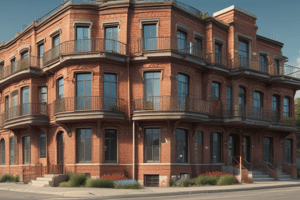Podcast
Questions and Answers
What is one method to protect vessels from accidental flooding?
What is one method to protect vessels from accidental flooding?
- Reduce the number of compartments
- Add double bottoms (correct)
- Increase the size of the vessel
- Use lighter materials for construction
Which SOLAS Convention mandated that ships should meet the two-compartment standard?
Which SOLAS Convention mandated that ships should meet the two-compartment standard?
- 1980 Convention
- 1910 Convention
- 1948 and 1960 SOLAS Convention (correct)
- 2009 Convention
What is a challenge faced in determining the damage stability of a vessel?
What is a challenge faced in determining the damage stability of a vessel?
- Ships are immune to damage
- All cargo must be unloaded
- Construction materials are not available
- The location and extent of damage is unknown in advance (correct)
Which types of vessels were included in the regulations after 1970 regarding subdivisions?
Which types of vessels were included in the regulations after 1970 regarding subdivisions?
What was an outcome of the SS Mohawk and SS Morro Castle incidents in the mid-20th century?
What was an outcome of the SS Mohawk and SS Morro Castle incidents in the mid-20th century?
What is one key analysis conducted in modern damage stability assessments?
What is one key analysis conducted in modern damage stability assessments?
What might be a consequence of adding subdivisions to a ship?
What might be a consequence of adding subdivisions to a ship?
What historical advancement took place in the 19th century regarding ship design?
What historical advancement took place in the 19th century regarding ship design?
Flashcards
2-Compartment Standard
2-Compartment Standard
A ship can remain afloat after the complete flooding of any two adjacent watertight compartments.
Stability
Stability
The science and art of designing and operating ships to maintain a stable and upright posture in various conditions.
Floodability
Floodability
The ability of a ship to remain afloat after flooding.
Subdivision
Subdivision
Signup and view all the flashcards
SOLAS
SOLAS
Signup and view all the flashcards
Advanced Softwares
Advanced Softwares
Signup and view all the flashcards
Damage Stability
Damage Stability
Signup and view all the flashcards
Damage Control Measures
Damage Control Measures
Signup and view all the flashcards
Study Notes
Course Information
- Course title: Introduction to Damage Stability
- Course code: NA 5
- Instructor: Engr. Dweena Maye V. Zamora
- Time: WTh 1:00PM – 5:30 PM
- Location: ITB Comlab
Table of Contents
- Introduction
- Historical Timeline
- Example
- Plate 1
- Instructor's Tips & Contact Details
Introduction
- Diagrams of buoyancy force, weight, and the metacentric height (GZ) are shown in relation to a vessel
- The presentation discusses how to protect vessels from accidental flooding
- Methods of protection are shown, such as adding watertight bulkheads and double bottoms
Challenges
- Location and extent of damage are unknown beforehand
- Cargo/liquid amount, type, and location varies between voyages
- Ship officers may not follow corrective measures
- Adding subdivisions will increase the cost and weight of the ship, possibly making it uneconomical
Historical Timeline (19th Century)
- Addition of fore and aft peaks and bulkheads to separate machinery and cargo holds
- 1929 SOLAS Convention improved in 1936 due to issues like the SS Morro Castle (1930) and SS Mohawk (1935)
- 1948 and 1960 SOLAS Convention resulted in the increase of ships required to meet the 2-compartment standard. A ship can remain afloat even after complete damage to any of its two adjacent watertight compartments
Historical Timeline (After 1970)
- Subdivisions were not only limited to passenger ships, but also included the following:
- Bulk Chemical Carriers
- LNG Carriers
- Tankers
- Mobile Offshore Drilling Units
Current Timeline
- Analysis of floodability and stability in longitudinal and transverse directions using advanced software
Example
- A ship at night is present in the graphic
Plate 1
- Instructions: Form groups of at most 3. Read and summarize the research on Buoyancy, Stability, and Subdivision from Archimedes to SOLAS 2009
- Instructions: Create a summarized timeline of the research content in A4 format using the rubric below
- Completeness: 45%
- Presentation: 25%
- Creativity: 20%
- Time-management: 10%
- Instructions: Submit outputs in PNG format to the given link before the January 23, 2025 deadline. Write your names on the output.
Studying That Suits You
Use AI to generate personalized quizzes and flashcards to suit your learning preferences.




